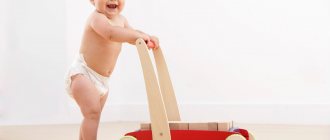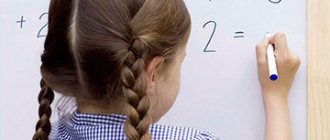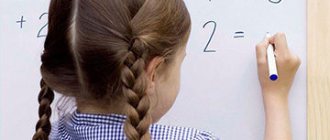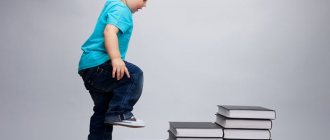Home Children Development
Those who claim that teaching a child to skate is unrealistic need to pay attention to the size of the skates. Manufacturers produce such “shoes” from size 25. And this already says a lot! All that remains is for parents to understand how much this activity is in demand for the child (based on the general list of available leisure activities), and also whether skating intersects with the hobbies of at least one of the family members.
This sport has value only as an entertainment event, which has a positive effect only on the formation of muscles, thanks to the timely giving of elasticity and permissible stretching under natural load.
Ultimately, if a final decision has been made regarding the need to educate a child, it is worth deciding on the optimal age and weighing all the disadvantages and positive aspects of such an activity. Which, in fact, will be discussed further.
Age to start training
To decide at what age it is necessary to start classes, it is important for parents to take into account the child’s level of physical fitness. However, experts advise not to rush, even if the child is well prepared and has endurance and strength.
Advice
The best time to start studying is 4-5 years.
You can start training in the following cases:
- when the baby has good coordination of movements;
- has developed leg and back muscles for his age;
- expresses interest in skating and a desire to learn.
If you start classes at 2.5-3 years old, this can lead to injuries and cause a persistent aversion to speed skating and physical education in general.
What you need for training
In addition to the child’s desire and reaching the age of 5 years, it is impossible to force him to do something against his will, it is necessary:
- buy protective elements of the suit;
- warm clothes, preferably with padding polyester lining;
- availability of an instructor with skills in such work;
- provide instruction regarding the dangers of using skates for purposes other than their intended purpose;
- shoes;
- the presence of auxiliary elements to maintain balance;
- the constant presence of one grown within a range of several meters.
All these points are important to implement, since without them it is impossible to begin training, which, by the way, begins with the most difficult part - moral preparation.
Skate selection
The key factor in the success of teaching a child to skate at 4 years old is the right choice of skates. They must be of high quality, safe and meet the following requirements.
- Be the right size. To avoid mistakes, shoes should be tried on with a woolen sock, which the child will then wear on the ice. Skates should not squeeze the foot or be too loose.
- It is best to choose blades on children's skates that are short but well sharpened. For beginners, they are optimal because they help maintain balance.
Next, the choice of skates depends on the purpose.
- If parents plan to send their child to the sports section, where he will continue his activities, they should choose from leather models.
- For hockey lessons, it is best to immediately accustom your child to hard plastic skates.
Finally, thermal skates are very comfortable for the feet, but they are quite expensive.
Experts advise choosing simple but reliable skates for children (like Snow Maidens, Polikarpov skates) - they will help the beginner maintain balance, do not have pointed ends, and therefore are safe. When choosing boots, you should take into account that they should properly fix the ankle joint that is poorly developed in children.
How to choose skates for a child
It is not necessary to immediately choose expensive professional skates for your child, especially if the future skater is still a preschooler. To begin with, you can get by with budget figure skates or hockey skates from the famous Russian ones, “Snegurochka”. The main thing when choosing children's skates is to choose a model that will be as comfortable as possible.
Skates for beginners
When choosing children's skates, pay special attention to the density of the material from which the boots are made - in boots that are not rigid enough, the child runs the risk of injuring his shin. You can check the stiffness of the boots like this: try to bend the boot to the side from the heel. A boot that is safe for children to ride on will bend a maximum of 30 degrees.
Other important parameters of good skates for beginners:
- short, sharp blades;
- the best material for children's skate boots is genuine leather;
- if you plan to subsequently enroll your child in a hockey section, choose the toughest model.
How to choose the size of skates for a child
Of course, children's feet grow quickly and there is a great temptation to buy skates for growth. But it’s still better not to do this - if you want the skates to last more than one season, choose from models that are adjustable in several sizes.
Before purchasing, be sure to try on the skates for their future owner. Boots worn with thick toes should not be too wide and should not pinch the foot. Ask your child to try skating, and if he is comfortable, you can buy the chosen model.
Choice of clothes
In order for your child to be interested in learning to skate, you should purchase a high-quality suit for him that he will like. Therefore, it is better to go to the store for a new item with your child, be sure to take into account his opinion - if he does not like the new clothes, there is a risk that he will hate the classes.
Parents should be prepared to purchase the following equipment:
- the skates themselves;
- helmet;
- knee pads;
- comfortable trousers for the skating rink;
- fashionable scarf, hat and mittens.
Advice
To allow your child to participate in the purchase, you can find 2-3 suitable options and invite your child to choose from them.
What is the benefit
In addition to developing a sense of beauty and excellent athletic training, dancing and jogging on ice has many other advantages:
- Ice skating is beneficial for those who want to become healthier. In the process, all muscle groups are strengthened, the lungs and heart receive an additional volume of oxygen, posture and well-being improve.
- This sport is fun for both adults and children. As a result of classes, such qualities as perseverance, determination, attentiveness and composure are formed.
- Spending time at the skating rink is great leisure time for the whole family. The baby is not able to master the technique on his own, so the presence of mom or dad is mandatory.
Important! Ice skating can be dangerous for children with problems with the spine and joints, as well as the nervous and cardiovascular systems. Before buying equipment, consult a doctor - pediatrician, orthopedist, neurologist.
Before going to the skating rink
It should be remembered that the child is starting to engage in a new activity, so he will experience excitement - we need to help him gain self-confidence.
Experts recommend doing this.
- Watch a video with your child where children his age learn to ride, and you should select fragments where the children not only make progress, but also fall, after which they do not give up and continue training again.
- Put all the clothes, equipment, and skates on the baby at home.
- Give him the opportunity to walk in such unusual shoes on a non-slip surface.
It is best to teach your child how to maintain balance at home, before going on the ice. To do this, you should ask him to do the following:
- Stand up straight.
- Place your feet shoulder-width apart with your knees slightly bent.
- Turn your socks slightly to the sides.
- Bend forward so that your shoulders are level with your hips.
- Spread your arms to the sides.
First, this exercise is performed barefoot or in regular shoes, then on skates.
Parents who want to teach their child to skate should adhere to the following recommendations from experts.
- For your first acquaintance with ice, it is best to choose an indoor skating rink - there is no wind and it is warmer than outside. It’s even better if there are very few people, so the baby will feel calmer and more confident.
- Pants for the first lesson and all subsequent workouts should not be narrow, restricting movement.
- The jacket you should choose is thick but light.
Having decided that the child is ready to learn directly at the skating rink, you should perform one more preparatory action - give him the opportunity to stand on skates outside - for example, on a snowy area - while maintaining balance. At first, the child can hold on to a support or give a hand to his parents, but it is important to ensure that he can hold on himself.
First steps on ice
my-sunshine.ru
1. When your child is ready, start practicing on the ice. It is best if it is a skating rink where the number of visitors will be minimal so that you can study in peace.
2. First, place the child at the side, let him try to move around the support and get used to the ice.
3. Then invite your child to ride with you hand in hand. The child should only be held as a fall protection and should not be pulled or allowed to hang from your arm. Do not insist under any circumstances if the baby is afraid and refuses! Even if he just rides along the side for the first time, it’s okay.
4. Let your child try to walk in small steps without your support. If the child is afraid, then continue to ride by hand. Don’t shame your child for being “cowardly” and don’t force him, otherwise next time it will be difficult to lure him to the skating rink.
5. The next stage is walking in a herringbone pattern. The movements of the legs when skating are in different directions alternately. First, you can try to take steps a little to the side, and then slide. Hold your child's hand if necessary.
6. You can try to slide, keeping your legs parallel to each other, while smoothly turning your toes to the left and to the right. Start performing new exercises, holding the child's hand, until the baby feels confident in his actions.
7. Practice braking on ice. To do this, you need to pick up speed, accelerate with the child and protect him from falling when braking. The child needs to feel the speed and force of pressure to brake. Remember all three methods.
8. Practice your turns. To turn, you need to bend your legs, sliding parallel, and with a slight tilt forward, tilt your torso in the direction in which you want to turn. On ice, turns train coordination well: the greater the slope, the stronger the turn. For an advanced level, the exercise can be complicated by pushing off with the outer edge of the skate. This will help reduce the turning path.
Fall training
It is extremely important to help your child learn proper falling techniques to avoid serious injury.
Parents need to tell their kids in detail how to fall safely.
- Try to group and crouch while falling, this will make the blow almost imperceptible. But if a child falls backwards, they can seriously injure their head or back.
- If you cannot group yourself, it is better to fall on your side; this will also avoid serious injuries.
- If falling backwards cannot be avoided, the child must try to move into the fetal position and bend over. When falling forward, it is important to protect your head with outstretched arms.
Advice
The child will feel more confident if he rehearses every safe fall technique at home.
It is equally important to tell your child how to get up correctly after a fall:
- take a “on all fours” position;
- place one foot resting on the blade of the skate;
- the hand rests on the knee of this leg;
- with muscular effort you should “push” yourself forward.
Getting back up properly after a fall should also be practiced at home.
How to dress a child for ice skating?
- First of all, you need to choose the right skates.
It is best to try on skates directly on a wool sock. Typically, skates are taken 0.5-1 sizes larger than shoes. It is important that the heel is fixed. It's easier to skate with shorter, well-sharpened blades.
- Sports thermal underwear retains heat well and wicks away moisture.
- A fleece jacket under the neck, so that you don’t need a scarf, will help you stay warm and prevent you from sweating.
- Waterproof pants with straps to keep the back covered. Insulated pants will help cushion your fall.
- The hat is lighter for an indoor skating rink and warmer for an outdoor skating rink.
- Thick mittens (even for an indoor skating rink), since no one is safe from falls, especially at the learning stage.
- For the street, all that remains to add to this set is a short jacket so that it does not restrict the movement of your legs.
- Protection for the first time: knee pads, elbow pads and possibly a helmet.
You can teach your child to skate with the whole family - you will have a great time. This is useful for strengthening the immune system, developing coordination, stamina and determination.
Share in the comments how you learned to skate and how you teach it to your children.
First time on the ice
To teach a child to skate, it is very important to conduct the first lesson in such a way that the child develops interest, a sincere desire to train, and does not develop disgust.
The first lesson should consist of the following structural elements.
- A little warm-up. It is enough to jump a little and sit down once.
- Monitoring parents. They must show the child their skills in order to make him want to learn how to ride the same way.
- Introduction to the ice. It is important that the child stands on skates for some time without the help of an adult. If he is afraid, you can take his hand for a while, then let him go. It is important to show your child how to stand on skates correctly, tilting the body slightly forward.
- First step. Taking the child by the hand, the parent helps him take the first step on the ice. To glide correctly, teach your child to push off with his legs in turn, transferring weight from one leg to the other.
Advice
The first training can be completed even with a simple ride in a straight line: the child rides on his own, tries to keep his balance, but holds on to his parent for confidence.
If the child wishes, other basic exercises on ice can be included in the first lesson:
- walking in place (you need to try to maintain balance);
- movement forward and backward;
- “snake” - you should ask the child to draw two “snakes” (wavy lines) on the ice, making movements with their feet. To do this, place the legs so that the feet are together, then make a movement to the right, then to the left.
If a child fails at something, it is important for parents to support him, praise him for his success or effort, this is the only way to achieve the desire to continue studying.
How to teach a child to skate correctly: basic exercises and techniques
Before the child gets on skates, show him what ice skating is like. For example, you can walk to the nearest skating rink - even an improvised one - and see how children skate there, or turn on a video of beginner skaters.
The most logical way to teach a child to skate is in the following order:
- first steps outside the skating rink;
- stand training;
- way to fall safely;
- various skating techniques and related elements.
Where to start: first steps
First, invite your child to go ice skating at home. Leave the blades covered, and ask the boy or girl to try walking ten steps, waving their arms, and squatting.
When the child begins to feel quite confident on skates at home, it’s time to take his first steps outside. There is no need to immediately try your hand at the skating rink: if there is a not too slippery area in the yard, it is optimal to take your first steps there. On a not very slippery surface of the playground, the baby can walk, practice maintaining balance, and learn to stand correctly.
Don't worry about the health and safety of your child when you let him go to the skating rink or for a walk without your accompaniment! Always know where he is and what route he is taking, listen to what is happening around him, and also call in any situation using the “Where are my children” application.
Correct stance
Try to teach your child how to skate correctly without leaving home. How to teach your child a safe skater stance:
- put skates on your feet, and, if possible, the rest of the equipment in which the child will begin skating on ice in the future;
- place your feet so that they are at a narrower distance than shoulder width, bend your knees slightly;
- raise your arms and spread them to the sides for greater stability;
- tilt your body forward;
- try doing squats - this way the child will feel how to maintain balance;
- When the squats start to work out, try walking around the apartment. The adult’s task is to remind the son or daughter that the body should always be tilted: if the child, through inattention, often straightens the body on the ice, he risks getting injured due to falling on his back.
Fall technique
No one, including figure skating champions, has been able to learn to skate and never fall. Falling during training is normal, but it is very important to teach a beginner skater how to fall correctly: careless falls on the ice can cause bruises, contusions and other injuries. And if a child regularly begins to receive noticeable bruises while skating, the desire to go on the ice will disappear forever.
Most often, falls do not occur during skating itself, but at those moments when the skater straightens his body, stopping. Constantly remind your child of the importance of tilting the body, and rehearse falls in advance without leaving your house or apartment:
- throw a thick blanket or blanket under your baby’s feet;
- ask the child, pre-shod in skates with sheathed blades, to group, not completely squat, and fall to his knees in knee pads;
- Explain to your son or daughter that if you fail to group in time, you should try to fall on your side, avoiding falling backwards;
- tell your child that even if he understands that falling back cannot be avoided, there is no need to panic, you need to try to take the shape of an embryo, rounding your back and pressing your chin to your neck;
- try falling at home until the falling technique is brought to automaticity.
After a fall, it is equally important to get up correctly:
- Explain to your child that no matter what position he finds himself in after a fall, before getting up, he must get on all fours;
- Next, you need to firmly lean on the blade of the skate on your leading leg (right leg for a right-hander, left leg for a left-hander);
- Then you need to lean your hand on your leading leg and vigorously push your body forward to rise from the ice.
Child safety in winter: important rules of behavior and a reminder for parents on first aid.
Skating
Before the first and all subsequent rides, invite your child to warm up: squat several times, rotate his hands and body, jump or rise on his toes several times.
After warming up, you can go out on the ice. Until the baby feels at least relatively confident while skating, he will need to be accompanied by an adult family member. For the very first time on the ice, you can perform a minimum set of exercises for beginners:
Passage along the side
Turn to face your baby, take his hands and move along the side together at a calm pace. Make sure your student rests firmly on the blades without hanging onto your arms. To teach children five years old and older to pass along the side, you can use a tug, for example, a stick or another similar object: the adult also moves facing the child, only the baby does not hold on to the hands of mom or dad, but to the stick extended to him. With the help of a tug, the child will immediately get used to not leaning on the hands of an adult and will better maintain balance.
Small steps
Ask your son or daughter to walk on the ice in small steps without slipping. Regular steps - without trying to slide for now - are more familiar to a little person and will help him cope with anxiety.
Squats
Another way to learn how to maintain balance on ice. Invite your child to do squats in one place with his arms spread to the sides.
Sliding for beginners
Sliding on two legs at the same time without lifting the legs off the surface. You will need the help of an adult: you can move alongside, holding the child’s hand.
Normal sliding
Show how skaters glide: they alternately push their legs off the surface, while simultaneously transferring weight from one side of the body to the other. Let the baby try to do the same.
Braking
The easiest way to slow down for those who have just begun to master skating is to stop, placing emphasis on the heel of the leading foot. Braking technique for beginners:
- place the skate of the leading leg against the movement, resting on the heel;
- bend the other leg at the knee;
- When braking, the body moves forward by inertia - and in order not to lose balance, you need to slightly tilt the body back.
When the child learns to successfully brake with his leading leg, learn to stop with the second leg.
A little later, demonstrate to your baby other methods of braking:
- press the back of the skate into the ice, as if trying to screw the blade into the surface - this method is especially suitable for emergency braking;
- a method called “plow”: the legs are bent at the knees, the heels are spread in different directions, and the feet and knees, on the contrary, are brought together - from this position you need to brake with both legs at the same time;
- Another method of braking is for those who have already learned to brake in simpler ways: the skater turns to the side, puts one foot on the outer side of the blade, and the other foot on the inner.
Turns
Learning to turn on ice is quite simple: just lean in the direction where the skater is going to turn and push with the outer edge of the skate. Remind your child that you cannot straighten your leg when the turn has already been made - otherwise you may fall. Tell us that to make a sharp turn you need to tilt your body as low as possible.
Simple exercises on ice for children
To consolidate and develop skating skills, invite your child to do simple exercises on ice:
- Walking plus “Sleigh”. Starting position: feet together, arms to the sides. How to do it: take two steps forward, squat so that your buttocks point towards your heels, spread your arms and legs in different directions, try to ride on both legs in this position.
- Exercise “Christmas tree”. Starting position: legs bent at the knees, heels together, toes slightly apart. How to do it: move your legs one at a time, pushing off the surface with the ribs of your skates, trying not to use the teeth for movement.
- Exercise "Flashlight". Starting position: legs together, knees bent, body tilted. How to do it: the child begins the movement - independently or with the help of an adult - and successively spreads his legs to the sides and brings them together again, as if drawing semicircles or a figure in the shape of a flashlight with skates.
- Exercise "Half-flashlight". Starting position: the supporting leg is bent at the knee, the other leg is straightened and set aside. How to do it: push off with only one leg, drawing a semicircle with your skate, then only with the other leg.
- Exercise "Snake". This exercise is a bit like the exercise of the same name for motorists. Starting position: legs spread slightly wider than shoulders, torso leans forward. How to do it: push off the surface with your feet one by one, using the outer edge of the skate, while your free leg slides on the inner edge.
Basic exercises
You won’t be able to teach your child even the basics in one lesson, so you need to prepare for long-term hard work.
You should perform a few simple exercises to help you maintain your balance on a slippery surface.
- Steps. When performing this exercise, the child should take the most ordinary, familiar steps, placing support on the entire foot. In order for him to feel confident, the parent must hold the baby's hand.
- "Herringbone". A more complex option that allows you to learn how to slide: the right leg is placed not straight, but diagonally. You need to push off with your left foot (the inside of the blade) so that your right foot smoothly slides forward and slightly to the side. After this, the legs are changed.
Advice
It will be interesting for the child to watch his “work”: such steps leave marks on the ice, similar to a Christmas tree.
- Braking. To perform this, push off and bring your legs together. Then open and close again, using your heels as support. This exercise helps teach your baby to slow down.
- "Lanterns." Push off and place your feet together. Then spread them apart again and bring them together. Run several times.
Advice
It is not necessary to include all the steps in one lesson, but if the child is making progress, you can explain more to him. But if the baby is tired, begins to be capricious, or encounters difficulties, it is better to stop training.
Equipment for learning to skate
my-sunshine.ru
Going to the skating rink together guarantees a fun and useful time. Don’t be embarrassed by the fact that you yourself are not good at standing on sharp blades - this is not at all a reason to deny yourself and your child pleasure. At large venues there are devices that help beginners get used to it. Stable toys on skis (weighing about 15 kg) glide perfectly on the ice and act as a support. You can choose a stand according to the height of the child.
rebenkoved.ru
Braking training
It is very important to tell your child how to brake correctly. There are three main methods - it is better to show the baby everything so that he chooses the most convenient option for himself.
- One foot forward. Thanks to this method you can brake at high speed. The legs are parallel, knees bent. One leg is placed forward 90°, with its help you need to press on the ice. The second leg allows you to maintain balance and avoid turning.
- One foot back. This method is similar to the first, only in this case one leg is placed at an angle of 90° back, balance is maintained by the leg that is located in front.
- Heel. The legs, slightly bent at the knees, are parallel, one leg is brought forward and placed on the heel. The second is bent at the knee and maintains balance. After this, the legs are placed parallel again.
- Plow. The legs are slightly bent and the toes are turned inward. Braking is performed by both skates.
Each method should be shown to the child, explained in detail, and mistakes worked out.
Mastering skating
Once the little athlete gets the hang of it, complicate the task and teach the following exercises:
- "Herringbone" .
At the start, keep your heels together and your toes slightly to the sides. The legs, slightly bent at the knees, need to be moved one after the other. It is correct to push off not with the teeth of the skates, but with the edge. - "Lanterns" . The child begins to move, accelerating slightly or holding the hands of an adult. The feet are alternately held parallel, then spread apart, then brought together again, describing a circle, as if going around an obstacle.
- "Snakes" . The feet are kept parallel to each other, the movement occurs in waves, the legs seem to draw a snake trail on the surface.
Learning to turn
The next stage of training is learning to turn. To do this, you should act like this.
- One leg is put forward (the one towards which the turn is planned).
- The body tilts in the direction of rotation.
- The higher the speed, the sharper the turn will be.
Parents should practice turning in both directions with their child, paying attention to common mistakes:
- the wrong leg is often brought forward;
- When entering a turn, the leg straightens.
The baby must understand that if he makes a low landing, he will be able to more successfully maintain his balance.
Start of training
First, it is important to prepare the child mentally. Some children think that they will be able to slide immediately after stepping on the ice. If he realizes that even professional athletes fail at first, his failures won't seem so insurmountable.
It is important to teach him to fall correctly at home over a soft blanket. In indoor conditions, you can put on roller skates and all the necessary protection for your baby. After such preparation, the child will feel more confident on real ice.
Let's ride with a penguin
There are special devices by holding on to which the child will learn to maintain balance. They are called "penguin". Many parents have helped their child stand confidently on the ice with the help of such equipment.
Most models are quite heavy. This helps the child simultaneously develop the strength with which he will push off the ice in the future. Balance develops and soon the baby is ready for further learning.
How to overcome fear?
If a child is afraid to get on the ice, throws tantrums, is capricious, and then asks to continue training, to give him another chance, then the parents are required to show patience and not scold the child for cowardice. It is very important to support him, praise him for his efforts, and tell him that mom and dad are proud of him. Some children who fall on the ice and hit themselves painfully may experience a reluctance to exercise for a while, but this gradually goes away. Others feel self-doubt, are afraid of not being able to cope - they need to be supported, praised more often, and sincerely rejoice at their successes.
Teaching skating is not an easy task; parents will need time, desire, and patience. But years later, the child will be grateful that his dad or mom managed to help him get on the ice.
What clothes are needed
Since these are the first lessons, it will be enough to use simple home clothes, while significantly saving on the purchase of special kits. The latter can cost from several thousand, but do not have the initially required feature - protection against falls.
It is best if it is a light sweater and pants with a little fleece, into which outerwear can be easily tucked. This is important, because when you fall, snow can get under your clothes, causing not only discomfort, but also a greater likelihood of illness.
It is important to note that all clothing must have elastic on the sleeves and legs. This will prevent fabric from getting under the blade of the skates during the learning process, thereby eliminating all kinds of falls and other negative consequences.
When considering such simple requirements, we should not forget that all clothing should be breathable and the child should not be hot during training. The task of such selection is quite difficult, but any parent can cope with it.
First exercises
Each parent has their own method of teaching ice skating to their child. Training tactics are influenced by the child’s age and what kind of sport he will engage in in the future. It is important to choose an individual training regime that would bring positive emotions and pleasure to everyone.
Keeping your balance
A coach or parents should help you understand how to maintain balance. The following steps will help:
- put the child on a hard, dry surface so that he can feel what it feels like,
- before going on the ice, teach your child to lean forward a little to avoid falling backwards,
- ride it yourself so that the baby can feel the sliding and understand how to brake.
The form of training should be interesting. If you plan to play hockey, it is better to send your child to a specialized school.
Read also: Flip jump in figure skating
Slip
Parents must decide which skates are best for their child to learn to skate on, help him keep his balance, and only then move on to learning how to ride. The following elements can be worked on:
- herringbone walking
- walking independently without the help of adults,
- teach walking backwards
- knee lift,
- squats in place,
- move and spread your legs.
There is no need to try to teach your child to jump or walk on the teeth of the blades. These are dangerous stunts that professional figure skaters perform in their performances. It is important to show your child how to brake by turning his foot 90 degrees to the path of movement.
Learn how to fall correctly
While riding, the child will fall more than once, so it’s worth immediately teaching a lesson on how to do it safely. You need to spread a blanket on the floor and throw some pillows. This will be a fun and useful activity for the child.
During training, it is necessary to wear protection on the child. But you should not wear wristbands, as the child may develop a false sense of security and begin to put his hands forward. If a child gets used to doing this, there is a high chance of getting a broken arm or a dislocated joint while riding.
Tell your child how to properly group themselves when falling. Tell him that if he loses his balance while riding, he needs to lower himself or squat as low as possible, twist and fall to the side. Do not allow your child to fall on his stomach or back - he may injure his ribs and be knocked down by other riders. To avoid getting a concussion, you need to hide your head behind your shoulder when falling.
When to start
The sooner a child starts learning, the faster he will get used to it. A two-year-old child is already ready to get on the ice. The only question is whether your child is ready for this. There are many nuances here: personal characteristics, interest in ice and skating, presence/absence of fear. The last point is decisive: if a child is terribly afraid to put on skates and is unsteady on them on the ice, it is worth holding off on the lessons a little.
And vice versa: there are completely fearless and very curious children who will stand on the ice and will be happy to try to take their first steps on it. 2 years is the age when a child can start skating purely from a physiological point of view: his muscles are already formed, his coordination is sufficiently developed. But the average age to start classes is 4 years.
Rules for caring for skates
After each workout, you need to wipe the skates with a dry soft cloth and dry them at room temperature. Make sure that moisture does not remain on the blades - this can lead to rust!
If you are going to put your skates away for long-term storage, lubricate the leather with shoe polish, stuff the shoes with paper, and lubricate the blades with machine oil. Wrap your skates in paper and store them that way until next season.
What NOT to do:
- dry skates near radiators and heaters - this affects the skin of the skates and their internal structure.
— sharpen skate blades yourself. Trust professional equipment!
- sharpening the blades too often can significantly reduce its service life.
- walk on the floor, asphalt or steps without covers.
How to dress for the skating rink?
The main principle is that clothes should not hinder your movements. It is best to use thermal underwear specifically designed for sports activities - it breathes well and maintains a comfortable temperature. On top you can wear your favorite jacket and trousers. Don't forget your hat!
Training Rules
In order for the training to be as effective as possible and you can avoid most mistakes, you need to follow these rules:
- First of all, you need to pay attention to how you should lace your skates. The tightest part should be the instep area; it is better to lace the upper and initial parts looser. You cannot lace the shoe too tightly, otherwise blood will flow poorly to the baby’s foot. This can cause both pain and complications in movement.
- Make sure your child wears comfortable clothes. It should not hinder his movements, but should not be too spacious.
- Pay attention to how the baby breathes. It is important to teach him to make breathing movements through his nose, without holding in air.
- There is no need to overexert the child right away. During the learning process, skating should be replaced by rest. A 15-minute ride is enough to take a break.
- You should not allow your baby to sit, much less lie, on the ice.
- The child may be afraid, because of this his body will be constrained. Try to convince your child that nothing will happen to him. If something happens, he will be protected by equipment. It is important that the child’s body is relaxed, while the back remains level.
- Explain to your child that right away he will not be able to drive as fast as other adults, other children or people he has seen on TV. Let the first training sessions be smooth and gradual.
- It is important during the learning process not to allow the child to concentrate his attention on the ice. Therefore, when you eat next to your toddler, distract his attention in different ways so that he does not become fixated on what is under his feet.
- Make sure your baby's knees don't fall inward.
- Explain to the child that under no circumstances should you push off the ice with the toes of your skates. This can lead to bad consequences.
- When you put the skates on your child's feet, let him just stand on them for a while and learn to keep his balance.
- When the baby begins to ride, it is necessary that the knees are slightly bent and the body is slightly tilted forward.
- The first attempts to skate must be made holding the child by the hand.
- Explain to your child that you need to push off with the inner edge of the skate, while putting your other leg in front.
- You need to ride with your socks pointed in different directions. In this case, the body weight must be alternately transferred from one foot to another and move straight.
- Tell your child that in order to slow down, you need to simultaneously move your skates in different directions, then simultaneously bring your legs towards each other. In this case, it is important to sharply and firmly press your heels into the ice.
There is another braking option. To do this, one leg will need to be put forward and turned at a right angle relative to the movement. The main thing is to keep all your balance on the leg, which serves as a support.
We didn’t have skates and we don’t go to the skating rink. Actually, I have no desire to skate on ice. But my friend started teaching her daughter when she was still 4 years old. Now the baby is 5 years old, and she skates as well as any adult. Although initially the learning process was not so easy for them. The baby even fell often, it’s good that they took care of the presence of a helmet, knee pads and elbow pads.
Exercises
There are three main exercises to consider:
- Wave. To do this, it is necessary to push the legs together, then move them apart and then bring them together. In this case, an image of two waves will appear on the ice.
- Christmas tree. When performing this exercise, you need to place one skate slightly obliquely, while using the inner blade of the second skate you need to slowly push forward. The first leg will move straight and slightly to the side. When performing this exercise, you need to alternately perform a pushing movement with one leg and then the other several times. On the ice you can see the image of a Christmas tree.
- Octagon. The legs move apart at the same time, and then connect literally at one point. In this case, figure eights should form on the ice.











